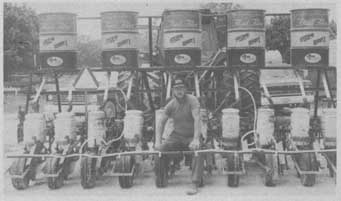
"It lets me plant 35 acres of soybeans on one fill. Saves a lot of time," says Donald Anderson, Alberta, Va., who mounted five 55-gal. steel drums on his 10-row no-till soybean planter.
Each drum holds 5 bu. of seed. Together with the planter's 1-bu. seed hoppers, the planter has a total capacity of 35 bu.
Anderson mounted the drums on a 2-ft. wide wooden catwalk that he built over the planter. A pair of 3-ft. long, 1 1/ 2-in. dia. pvc tubes run from the bottom of each drum to the row unit seed hoppers -- one tube to each hopper. Seed drops by gravity through the tubes and into the hoppers as they empty out.
Anderson plants up to 300 acres of soybeans each year. "I had been using an Allis-Chalmers 4-row no-till planter to plant corn in 36-in. rows, then added three row units between the existing row units to plant soybeans in 18-in. rows. However, I could go only 8 to 10 acres before having to refill the hoppers. I also wanted a wider planter.
"I didn't want to spend money on a new planter, so I bought a couple of used Allis-Chalmers 600 series planters, one 4-row and the other 7-row. I merged them to make a 10-row, 18-in. planter, then added the catwalk and five 55-gal. drums. I can fill the five drums just as fast as I could fill the hoppers on my old planter. Each drum holds about 300 lbs. of seed so I'm carrying 1,500 lbs. of extra seed. The extra weight helps the no-till coulters do a better job of penetrating hard or rolling ground. I use saddle tanks on my tractor to broadcast herbicide behind the planter."
The two converted planters were built with three separate toolbars to support the coulters, lift wheels, and row units. Anderson welded the toolbars together, beefing them up with channel iron. He used channel iron and angle iron to build the scaffold that supports the drums and mounted a couple of stepson one end. He used angle iron and 1 1/2-in. dia. pipe to build a safety railing in front of the catwalk. Drums are bolted to the catwalk between two lengths of channel iron.
"I put soybeans in old fertilizer bags and just back my pickup up to the cat-walk to dump seed into the drums," notes Anderson.
He cut a pair of 1 1/2-in. dia. holes in the bottom of each drum and mounted a bushing inside each hole to secure the pvc pipes. He ran the pvc pipes at a 45 degree angle down to within 1 1/2 ft. of the hoppers, then clamped a length of flexible rubber hose (designed for Deere grain drills) to the other end of the pipes. He cut a hole in the lid of each seed hopper and screwed the hoses into them, then used silicon caulking to seal them. The flexible hoses allow the planter to be raised and lowered without interrupting seed flow.
Anderson added bigger hydraulic lift cylinders to the planter and extra wheels (removed from an old Deere planter) to make tandem wheels. He still plants corn with his 4-row planter and just uses the converted planter for beans.
